跨文化交际 最终版
- 格式:ppt
- 大小:4.84 MB
- 文档页数:50
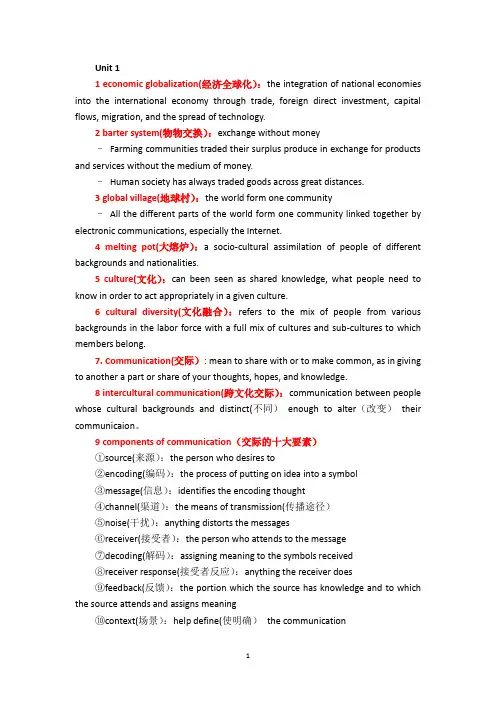
Unit 11 economic globalization(经济全球化):the integration of national economies into the international economy through trade, foreign direct investment, capital flows, migration, and the spread of technology.2 barter system(物物交换):exchange without money–Farming communities traded their surplus produce in exchange for products and services without the medium of money.–Human society has always traded goods across great distances.3 global village(地球村):the world form one community–All the different parts of the world form one community linked together by electronic communications, especially the Internet.4 melting pot(大熔炉):a socio-cultural assimilation of people of different backgrounds and nationalities.5 culture(文化):can been seen as shared knowledge, what people need to know in order to act appropriately in a given culture.6 cultural diversity(文化融合):refers to the mix of people from various backgrounds in the labor force with a full mix of cultures and sub-cultures to which members belong.7. Communication(交际): mean to share with or to make common, as in giving to another a part or share of your thoughts, hopes, and knowledge.8 intercultural communication(跨文化交际):communication between people whose cultural backgrounds and distinct(不同)enough to alter(改变)their communicaion。

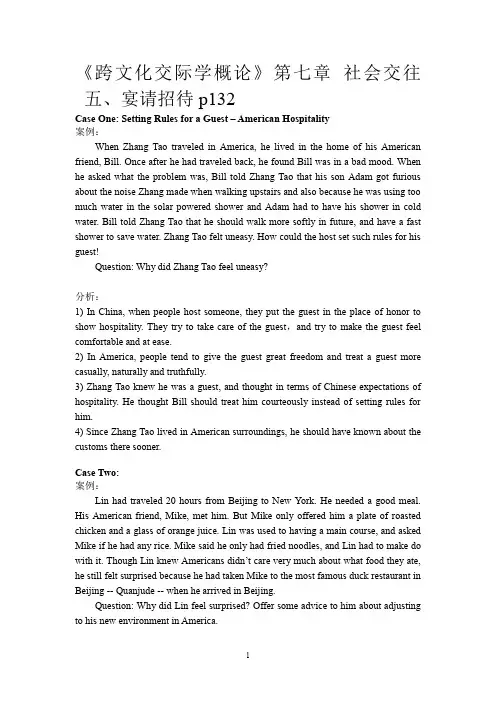
《跨文化交际学概论》第七章社会交往五、宴请招待p132Case One: Setting Rules for a Guest – American Hospitality案例:When Zhang Tao traveled in America, he lived in the home of his American friend, Bill. Once after he had traveled back, he found Bill was in a bad mood. When he asked what the problem was, Bill told Zhang Tao that his son Adam got furious about the noise Zhang made when walking upstairs and also because he was using too much water in the solar powered shower and Adam had to have his shower in cold water. Bill told Zhang Tao that he should walk more softly in future, and have a fast shower to save water. Zhang Tao felt uneasy. How could the host set such rules for his guest!Question: Why did Zhang Tao feel uneasy?分析:1) In China, when people host someone, they put the guest in the place of honor to show hospitality. They try to take care of the guest,and try to make the guest feel comfortable and at ease.2) In America, people tend to give the guest great freedom and treat a guest more casually, naturally and truthfully.3) Zhang Tao knew he was a guest, and thought in terms of Chinese expectations of hospitality. He thought Bill should treat him courteously instead of setting rules for him.4) Since Zhang Tao lived in American surroundings, he should have known about the customs there sooner.Case Two:案例:Lin had traveled 20 hours from Beijing to New York. He needed a good meal. His American friend, Mike, met him. But Mike only offered him a plate of roasted chicken and a glass of orange juice. Lin was used to having a main course, and asked Mike if he had any rice. Mike said he only had fried noodles, and Lin had to make do with it. Though Lin knew Americans didn’t care very much about what food they ate, he still felt surprised because he had taken Mike to the most famous duck restaurant in Beijing -- Quanjude -- when he arrived in Beijing.Question: Why did Lin feel surprised? Offer some advice to him about adjusting to his new environment in America.分析:1) 0n the topic of hospitality, the Chinese stress on warmth and demonstrating friendship. They take the guest to a famous or luxurious restaurant to have a very good (expensive) meal to show their hospitality. And the Chinese are used to having a big meal. The more dishes they put out,the greater the warmth and friendship they show.2) In western countries, people stress on freedom. They give the guest great freedom to choose their own foods. And westerners tend to have only one main course and some juice or dessert,which is viewed as casual in the eyes of the Chinese.3) Lin lived in American surroundings and should have adjusted himself quickly to the new world (lifestyle). He should have known the custom there first, and felt more at ease in Mike’s h ome.Case Three: Equality or Hospitality for Table Manners案例:Lin Hua has accompanied an American delegation to visit China. They have experienced the hospitality of the Chinese people. After returning to America, Linhua once visited them. They were so glad to meet again. Linhua offered to host the meal, but they refused. They ordered their own dish, and Linhua ordered her own. When footing the bill, they only paid their part,and no one wanted to pay for Linhua. Linhua found them so inhospitable, though she knew the Americans would usually pay for their own food.Question: Why did Linhua find them inhospitable?分析:1) In China, to show hospitality, people tend to host the meal. And if they cannot do this, they at least will struggle to pay for the guest.2) In America, people tend to pay for themselves to show equality and independence.3) Linhua knows this custom, but from a Chinese point of view, she still finds this hard to accept, and feels it a little inhospitable.Case Four:案例:I have an American friend. I have invited him several times, and at long last he invited me to his home one day. He told me to get there at 3 p m. I thought we could chat and have a meal together. I gave him a Chinese calendar, a woman’s scarf and a bottle of Chinese white wine. He only took out a dish of nuts, a plate of bread and a bottle of wine. After two hours’ chat, I found there was no hint of a meal and said good-bye to him. He only gave me a box of chocolate as a present for the New Year. After I got home, I found the box already been opened. I was very surprised, Question: What surprised me?分析:1) In China, a visit to home always includes a meal. And the guest always bringsa relatively expensive present to the host. And the present should be well wrapped or untouched.2) In the west, a visit to home only means a meeting, not necessarily including a meal. And the present is treated not as importantly as it is in China.3) I acted in a way that was based on Chinese customs, so I felt the American way was very interesting (unusual).Case Five: Way of Entertaining Guests in China ---- Drink more and more案例:Tom, an American, went to a Chinese home for the first time. He was offered some tea. Just when the first cup was about to finish, more tea was added. He drank the second cup. Then the cup was filled the third time. Then he drank it, then ⋯ until he was quite full. Tom was totally confused by the way of entertaining.Question: Why was Tom totally confused?分析:1) Traditional Chinese custom requires that during the course of entertaining, the host has to always pour more wine or tea to the guest’s glass or cup, and always adds more food to the guest’s plate or bowl without asking whether it’s wanted.2) Chinese guests know how to respond to this type of hospitality. They simply leave the wine, tea, or food in the container and stop having any more. But Tom, the American guest in the case didn’t know this.3) He followed the politeness rule of his culture: it’s not good manners to leave food in one’s own plate at a dinner table. Therefore, without any knowledge of the differences between the two cultures, an American guest would very likely suffer from either drinking or eating too much in such a situation.Case SixAs a foreign student at the University of Wisconsin in Madison, Keiko Ihara (Japanese) was on a strict budget. She had all her tuition and books paid for by scholarships and grants and until recently was comfortably housed in the dormitory. Wanting to live in the community rather than in the dormitory, she found a small apartment to share with a friend. Her college friends, knowing of her situation, offered to round up some of the necessary items for apartment living. Keiko politely declined, saying she could manage. Wanting to help out her friends found some old but still usable household appliances and furniture. Mary had an old desk that was in hergarage. Ed had some chairs from his uncle, and Joe and Marion had a few extra dishes. They cheerfully brought them over one day. Keiko seemed very embarrassed, but gracefully accepted them, sincerely and profusely thanked them.The following week they were each presented with a gift from Keiko. Mary got an ornate jewelry box, Ed a volume of woodcuts by a famous Japanese artist, and Joe and Marion a beautiful Japanese vase, all of which were of considerable worth and value, much more than the old things they had donated to her. They all protested that she could not afford to give such elaborate gifts; they really expected nothing as the household items were not really being used and they would rather have her use them. Keiko, however, insisted that they take the gifts. In the end, they accepted the gifts, although they all felt uncomfortable as they knew she was really sacrificing to give them.Questions:1. What do you think of Keiko insisting on giving valuable gifts to her college friends?2. Why did Keiko’s friends feel very uncomfortable when they received valuablegifts in return?分析:Keiko insists on giving valuable gifts to her college friends, because in countries like Japan, exchanging gifts is a strongly rooted social tradition. Should you receive a gift, and don’t have one to offer in return, you will probably create a crisis. If not as serious as a crisis, one who doesn’t offer a gift in return may be considered rude or impolite. Therefore, in Japan, gifts are a symbolic way to show appreciation, respect, gratitude and further relationship.Keiko obviously has taken those used items from Mary, Ed and Marion as gifts, for she probably doesn’t know that Americans frequently donate their used household items to church or to the community. Mary, Ed and Marion would never consider those used household items given to Keiko as gifts. No wonder they felt very uncomfortable when they received valuable gifts in return.Case SevenSelma, who is from the US, is in a student exchange program in Indonesia. One day, she was asked to attend a birthday party and she was delighted, for she was curious to know what an Indonesian birthday party was like. To her surprise, she was the only one that dressed in typically Western clothes. Although she had no strong reason to become uneasy, her uneasy feeling prevailed as the party was going on. To make herself feel better, she went to the food table and began to help herself. But, upon leaving the table, she tripped on the leg of a chair and spilled her drink on the floor. One of the girls stooped down to mop up the spill and everyone else laughed out loud. Selma, uncertain what to do next, quietly moved out of her way with her head lowered in shame.Questions:3. What functions does laughing serve in similar situations in China?4. What should we do to help ourselves or other people out of embarrassmentcaused by cultural differences in laughing?分析:Just like smile, laughing does not always serve the same function in different cultures. Interestingly, for us Chinese, laughing often has a special function on some tense social occasions. People may laugh to release the tension or embarrassment, to express their concern about you, their intention to put you at ease or to help you come out of the embarrassment. In this case, the people there were actually wishing to laugh with the American rather than laugh at her. Their laughing seemed to convey a number of messages: don‘t take it so seriously; laugh it off, it‘s nothing; such things can happen to any of us, etc. Unfortunately the American was unaware of this. She thought they were laughing at her, which made her feel more badly and angry, for in her culture laughing on such an occasion would be interpreted as an insulting response, humiliating and negative.。
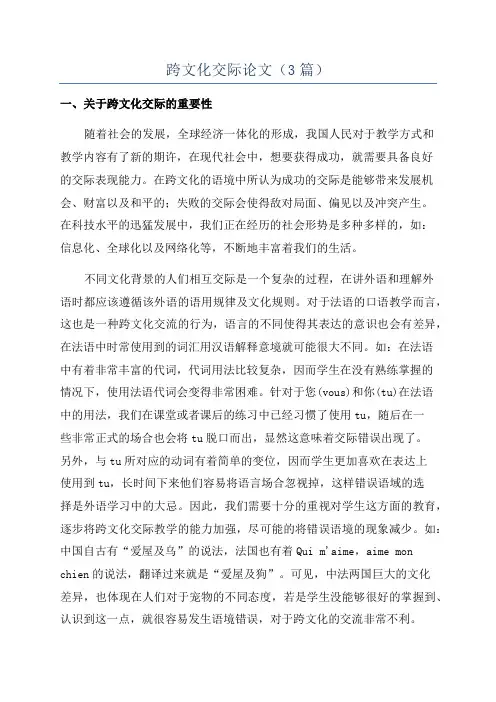
跨文化交际论文(3篇)一、关于跨文化交际的重要性随着社会的发展,全球经济一体化的形成,我国人民对于教学方式和教学内容有了新的期许,在现代社会中,想要获得成功,就需要具备良好的交际表现能力。
在跨文化的语境中所认为成功的交际是能够带来发展机会、财富以及和平的;失败的交际会使得敌对局面、偏见以及冲突产生。
在科技水平的迅猛发展中,我们正在经历的社会形势是多种多样的,如:信息化、全球化以及网络化等,不断地丰富着我们的生活。
不同文化背景的人们相互交际是一个复杂的过程,在讲外语和理解外语时都应该遵循该外语的语用规律及文化规则。
对于法语的口语教学而言,这也是一种跨文化交流的行为,语言的不同使得其表达的意识也会有差异,在法语中时常使用到的词汇用汉语解释意境就可能很大不同。
如:在法语中有着非常丰富的代词,代词用法比较复杂,因而学生在没有熟练掌握的情况下,使用法语代词会变得非常困难。
针对于您(vous)和你(tu)在法语中的用法,我们在课堂或者课后的练习中已经习惯了使用tu,随后在一些非常正式的场合也会将tu脱口而出,显然这意味着交际错误出现了。
另外,与tu所对应的动词有着简单的变位,因而学生更加喜欢在表达上使用到tu,长时间下来他们容易将语言场合忽视掉,这样错误语域的选择是外语学习中的大忌。
因此,我们需要十分的重视对学生这方面的教育,逐步将跨文化交际教学的能力加强,尽可能的将错误语境的现象减少。
如:中国自古有“爱屋及乌”的说法,法国也有着Qui m'aime,aime mon chien的说法,翻译过来就是“爱屋及狗”。
可见,中法两国巨大的文化差异,也体现在人们对于宠物的不同态度,若是学生没能够很好的掌握到、认识到这一点,就很容易发生语境错误,对于跨文化的交流非常不利。
二、培养学生跨文化法语口语交际的能力根据著名学者Gudykunst的理论,有效的跨文化交际能力应该包括基本交际能力系统、情感和关系能力系统、情节能力系统和交际方略能力系统。

Chapter 1 CultureDefinitions:1 Culture is the deposit of knowledge, experience, beliefs, values, actions, attitudes, hierarchies, religions, notions of time, roles, spatial relations, concepts of the universe, and artifacts acquired by a group of people in the course of generations through individual and group striving. 文化是个人和群体在种族发展过程中所获得的知识、经验、信仰、价值观、行为、态度、阶级、宗教、时间观、角色、空间观、宇宙观和艺术品的集合。
(P12/P29)2 Cultural Identity refers to one’s sense of belonging to a particular culture or ethnic group.文化身份:认为自己归属于某一文化或民族群体的感觉。
(P19/29)3 Subculture exist within dominant cultures and are often based on economic or social class, ethnicity, race, or geographic region.指存在于主流文化中的文化,其划分通常基于经济地位、社会阶层、民族、种族或地理区域.(P23/29)4 Subgroups usually do not involve the same large number of people and are not necessarily thought of as accumulating values and patterns of behavior over generations in the same way as culture do.相对于亚文化和共文化群体,亚群体通常规模不大,也不一定有文化群体世代相传积累的价值观念和行为模式。


Unit 1 Language and Culture in CommunicationTheory Communication is something we do every day. It takes place so naturally that we simply fail to notice it until it hiccups or breaks down. Though it is commonplace, it is no exaggeration to say that communication is life and life is communication.1.When you join a social gathering, you must be aware of rules and procedures that govern the way things are going to proceed. There is a technical term for such rules and procedures—schema.2. Face and politeness are two other areas which are extremely value—sensitive. One of the distinctive features of Chinese politeness is self—denigration and other—elevation.Case 1:Litz is a professor of cross—cultural communication in a university in Finland. She invited her Chinese students home for an evening party.The schema from Litz’s point of view includes the following:1. Giving invitation: by phone / by mail2. Prepare everything before the arrival of guests3. Receiving guests: open the door / express welcome / take their overcoats / introduce guests / offer them drinks / make them comfortable4. Serving food: set the table / soup first / main course / desert5. Post dinner activities: chat / play music / offer more drinks6. Seeing guests off: thank them for coming / good nightLitz’s evening party was not very successful, because she was upset by one of her guests. Here was the initial conversation between Litz and Lin:Litz: (opens the door) Oh, Lin, how nice you could come!Lin: It’s not difficult to find your house.Litz: Come on in.Lin: (comes in)Litz: Can I take your coat?Lin: No, thanks.Litz: Ok, this way please.Lin: (take off her coat and hangs it)Analysis: Litz was hurt because Lin did not let her hang her coat. Litz’s offering to hang Lin’s coat is one of Litz’s ways (it’s on Litz’s schema). On Lin’s side, she thought that Litz was her supervisor and that it was inappropriate to let her supervisor hang her coat. Here we have an instance of one action attached with different cultural values.Case 2:Finding an Interested BuyerGeorage Hall was in Beijing attending a trade fair and looking for an opportunity to do business in China. He had been very successful in his business dealings in the US and prided himself on his ability “to get things moving.” His first day was going well .He looked around at the displays of sporting equipment to get some idea ofwhom he might approach. He was sure that his products, tennis rackets with an unusual new design, would arouse some interests. On the second day he approached the company which he felt would be most responsive to his products. He introduced himself to the general, a Mr. Li. Since he had read that Chinese find getting down to business immediately too abrupt and rude, he began a casual conversation, eventually leading up to the topic of his products and suggesting how Mr. Li’s company might benefit from using them. George then suggested that he could arrange to get together with Mr. Li and provide more specifics and documentation on his products.Mr. Li responded in fairly good English,” That would be interesting.”Knowing that he had only a few days left in Beijing, George wanted to nail down a time,” When can we meet?” asked George.“Ah. This week is very busy,” replied Mr. Li.“It sure is,” said George,” How about 10 o’clock? Meet you here.”“Tomorrow at 10 o’clock?” asked Mr. Li thoughtfully.“Right,” said George, “I’ll see you then?”“Hmm, yes; why don’t you come by tomorrow,” was the reply.“OK,” responded George,” It was nice meeting you.”The next day at 10 o’clock he approached Mr. Li’s company’s exhibit only to find that Mr. Li had some important business and was not able to meet with George. He called back later in the day and was told that Mr. Li was not available.Analysis: 英美人士做事情讲究守时。
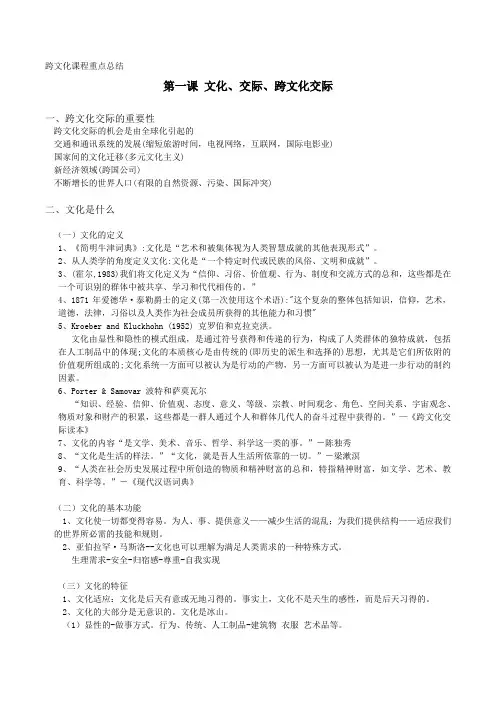
跨文化课程重点总结第一课文化、交际、跨文化交际一、跨文化交际的重要性跨文化交际的机会是由全球化引起的交通和通讯系统的发展(缩短旅游时间,电视网络,互联网,国际电影业)国家间的文化迁移(多元文化主义)新经济领域(跨国公司)不断增长的世界人口(有限的自然资源、污染、国际冲突)二、文化是什么(一)文化的定义1、《简明牛津词典》:文化是“艺术和被集体视为人类智慧成就的其他表现形式”。
2、从人类学的角度定义文化:文化是“一个特定时代或民族的风俗、文明和成就”。
3、(霍尔,1983)我们将文化定义为“信仰、习俗、价值观、行为、制度和交流方式的总和,这些都是在一个可识别的群体中被共享、学习和代代相传的。
”4、1871年爱德华·泰勒爵士的定义(第一次使用这个术语):"这个复杂的整体包括知识,信仰,艺术,道德,法律,习俗以及人类作为社会成员所获得的其他能力和习惯"5、Kroeber and Kluckhohn (1952) 克罗伯和克拉克洪。
文化由显性和隐性的模式组成,是通过符号获得和传递的行为,构成了人类群体的独特成就,包括在人工制品中的体现;文化的本质核心是由传统的(即历史的派生和选择的)思想,尤其是它们所依附的价值观所组成的;文化系统一方面可以被认为是行动的产物,另一方面可以被认为是进一步行动的制约因素。
6、Porter & Samovar 波特和萨莫瓦尔“知识、经验、信仰、价值观、态度、意义、等级、宗教、时间观念、角色、空间关系、宇宙观念、物质对象和财产的积累,这些都是一群人通过个人和群体几代人的奋斗过程中获得的。
”—《跨文化交际读本》7、文化的内容“是文学、美术、音乐、哲学、科学这一类的事。
”-陈独秀8、“文化是生活的样法。
”“文化,就是吾人生活所依靠的一切。
”-梁漱溟9、“人类在社会历史发展过程中所创造的物质和精神财富的总和,特指精神财富,如文学、艺术、教育、科学等。
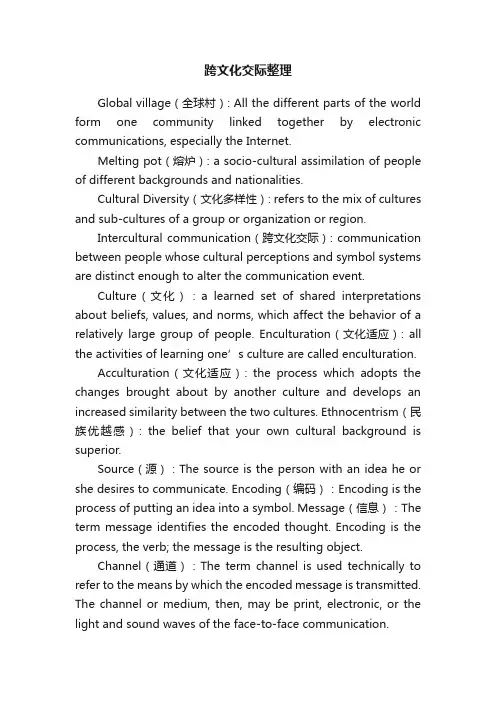
跨文化交际整理Global village(全球村): All the different parts of the world form one community linked together by electronic communications, especially the Internet.Melting pot(熔炉): a socio-cultural assimilation of people of different backgrounds and nationalities.Cultural Diversity(文化多样性): refers to the mix of cultures and sub-cultures of a group or organization or region.Intercultural communication(跨文化交际): communication between people whose cultural perceptions and symbol systems are distinct enough to alter the communication event.Culture(文化):a learned set of shared interpretations about beliefs, values, and norms, which affect the behavior of a relatively large group of people. Enculturation(文化适应): all the activities of learning one’s culture are called enculturation.Acculturation(文化适应): the process which adopts the changes brought about by another culture and develops an increased similarity between the two cultures. Ethnocentrism(民族优越感): the belief that your own cultural background is superior.Source(源):The source is the person with an idea he or she desires to communicate. Encoding(编码):Encoding is the process of putting an idea into a symbol. Message(信息):The term message identifies the encoded thought. Encoding is the process, the verb; the message is the resulting object.Channel(通道):The term channel is used technically to refer to the means by which the encoded message is transmitted. The channel or medium, then, may be print, electronic, or the light and sound waves of the face-to-face communication.Noise(干扰):The term noise technically refers to anything that distorts the message the source encodes.Receiver(接收器):The receiver is the person who attends to the message. Decoding(解码):Decoding is the opposite process of encoding and just as much an active process. The receiver is actively involved in the communication process by assigning meaning to the symbols received.Receiver response(接收者反应):Receiver response refers to anything the receiver does after having attended to and decoded the message.Feedback(反馈):Feedback refers to that portion of the receiver response of which the source has knowledge and to which the source attends and assigns meaning. Context(语境):Generally, context can be defined as the environment in which the communication takes place and which helps define the communication. Pragmatics(语用学): the study of the effect that language has on human perceptions and behavior.Semantics(语义学): the study of the meaning of words.Denotation(本义): the literal meaning or definition of a word --- the explicit, particular, defined meaning.Connotation(转义): the suggestive meaning of a word --- all the values, judgments, and beliefs implied by a word, the historical and associative accretion of the unspoken significance behind the literal meaning.Taboo(禁忌): some objects, words or actions that are avoided by a particular group of people, or in certain culture for religious or social reasons.Euphemism(委婉语): the act of substituting a mild, indirect, or vague term for one considered harsh, blunt, or offensive Chronemics(时间学): The study of how people perceiveand use time. Monochronic time: paying attention to and doing only one thing at a time. Polychronic time being involved with many things at once.Proxemics(空间学): the perception and use of space.Kinetics(身势学): the study of body languageParalanguage(副语言): involving sounds but not words and lying between verbal and nonverbal communication.A planetary culture(行星文化): a culture that integrates eastern mysticism with western science and rationalism Intercultural person(跨文化的人): represents someone whose cognitive, affective, and behavioral characteristics are not limited but open to growth beyond the psychological parameters of his or her own culture园林工人:landscape engineer 理发师:tonsorial artist 清洁工:sanitation engineer 补鞋匠:shoe rebuilder 发疯的:soft in the head 撒谎:reckless disregard for truth 偷窃:to take things without permission 劳资关系紧张:industrial climate天网恢恢...:justice has long arms 棋逢对手:diamond cut diamond金玉良言:golden saying 肥缺:fat office 船到桥头自然直:you will cross the bridge when you get to it 宁为鸡头,勿为牛后:better be the head of a dog than the tail of a lion 牛饮:drink likea fish 如履薄冰:tread upon eggs1.What are the four trends that lead to the development of the global village? Convenient transportation system; innovative communication system;economic globalization; widespread migrations2. What are the three ingredients of culture?Artifacts (the material and spiritual products people produce);behavior (what they do) ;concepts (beliefs, values, world views…) (what they t hink) 3.Characteristics of culture?Culture is shared; culture is learned; culture is dynamic; culture is ethnocentric4.Characteristics of communication?Communication is dynamic; irreversible; symbolic; systematic; transactional; Contextual5. How is gender different from sex?Sex: biological、permanent、with an individual property.Gender: socially-constructed、varied over time and across cultures、with a socialand relational quality.6.. How is Chinese addressing different from American addressing?The Americans tend to address only with given names while the Chinese may use the full name. Even when the full names are used in some formal accessions by the Americans, the given names would be placed before the surname while the Chinese would do the opposite.Chinese often extend kinship terms to people not related by blood or marriage while the Americans seldom do so.The Chinese tend to address the people with titles but in English only a few occupation or titles could be used.7.What are the different features of M-time and P-time?M-time is noted for its emphasis on schedules, segmentation, punctuality and promptness. It features one event at a time and time is perceived as a linear structure. P-time is less rigid and clock-bound. It features several activities at the same time and time is perceived as more flexible and more human-centered.8. What has influenced the gender socialization?According to researchers, there are two primary influenceson gender socialization: family communication, particularly between mothers and children, and recreational interaction among children.9.What are the American/Chinese cultural values like in terms of Cultural Orientation put forward by Kluckhohn and Strodtbeck? (ppt中的补充内容)As far as the human nature is concerned, American culture holds that it is evil but perfectible through hard work. As to the relation of man to nature, they think mankind can conquer nature. They also have a linear time concept and therefore they are future-oriented. They focus on doing and think that only actions can solve the problem. They are quite individualistic and therefore they focus less on the benefits of the group.As far as the human nature is concerned, Chinese culture holds that it is good but corruptible without proper education. As to the relation of man to nature, they think mankind can live in harmony with nature. They also have a cyclical time concept and therefore they are past-oriented. They have a being-and-becoming attitude towards activity and think that man should keep an inner peace as nothing is eternal. They are quite collective and therefore they focus more on the benefits of the group.)。

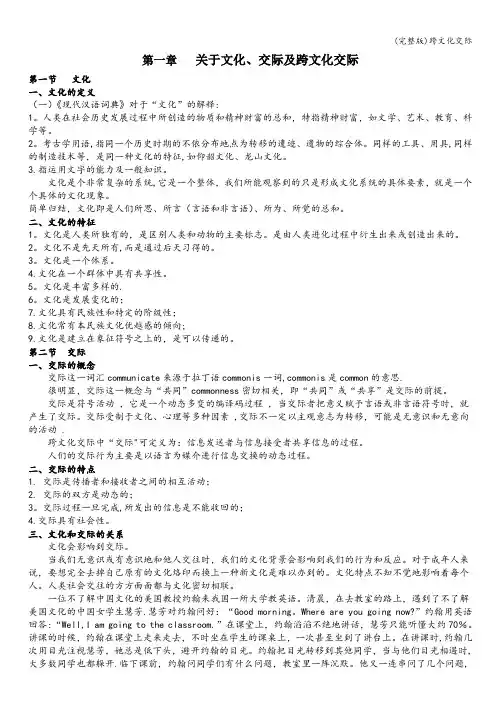
第一章关于文化、交际及跨文化交际第一节文化一、文化的定义(一)《现代汉语词典》对于“文化”的解释:1。
人类在社会历史发展过程中所创造的物质和精神财富的总和,特指精神财富,如文学、艺术、教育、科学等。
2。
考古学用语,指同一个历史时期的不依分布地点为转移的遗迹、遗物的综合体。
同样的工具、用具,同样的制造技术等,是同一种文化的特征,如仰韶文化、龙山文化。
3.指运用文字的能力及一般知识。
文化是个非常复杂的系统,它是一个整体,我们所能观察到的只是形成文化系统的具体要素,就是一个个具体的文化现象。
简单归结,文化即是人们所思、所言(言语和非言语)、所为、所觉的总和。
二、文化的特征1。
文化是人类所独有的,是区别人类和动物的主要标志。
是由人类进化过程中衍生出来或创造出来的。
2。
文化不是先天所有,而是通过后天习得的。
3。
文化是一个体系。
4.文化在一个群体中具有共享性。
5。
文化是丰富多样的.6。
文化是发展变化的;7.文化具有民族性和特定的阶级性;8.文化常有本民族文化优越感的倾向;9.文化是建立在象征符号之上的,是可以传递的。
第二节交际一、交际的概念交际这一词汇communicate来源于拉丁语commonis一词,commonis是common的意思.很明显,交际这一概念与“共同”commonness密切相关,即“共同”或“共享”是交际的前提。
交际是符号活动,它是一个动态多变的编译码过程,当交际者把意义赋予言语或非言语符号时,就产生了交际。
交际受制于文化、心理等多种因素 ,交际不一定以主观意志为转移,可能是无意识和无意向的活动 .跨文化交际中“交际"可定义为:信息发送者与信息接受者共享信息的过程。
人们的交际行为主要是以语言为媒介进行信息交换的动态过程。
二、交际的特点1. 交际是传播者和接收者之间的相互活动;2. 交际的双方是动态的;3。
交际过程一旦完成,所发出的信息是不能收回的;4.交际具有社会性。
三、文化和交际的关系文化会影响到交际。
跨文化交际论文范文关于跨文化交际论文(通用6篇)关于跨文化交际论文(通用6篇)【摘要】在全球经济一体化发展的背景下,跨文化交际逐渐的呈现出全球化趋势。
在跨文化交际中,不同的国家及民族之间价值所体现的差异性很容易给双方交流带来障碍,为此,对这种差异性进行研究,有助于不同文化背景的人在跨文化交际中避免或减少误解和冲突,本文以中美价值观为例,对这两种价值观产生的文化差异进行对比分析,以利于更好的了解中美价值观,促进中美跨文化交际。
【关键词】一、引言二、跨文化交际视阈下中美价值观的对比分析而在美国人的生活中“个人主义”扮演着非常重要的角色,他们非常崇尚自我意愿和个性化发展,这种特性在进行跨文化交际中表现的尤为显著,美国人往往会表达出强烈的自信和肯定,并且在表达观点时,喜欢标新立异和独辟蹊径,希望能够别具一格。
他们在生活中追求个性自由和个人享受,自由的抒发自我意志和发展自我思想。
这种差异在跨文化交际中表现为,中国人认为在公众场合自由的发表观点是“对人”的产物,很容易引起一些不必要的误会,而美国人认为即使在交际时争论的面红耳赤,也仅仅是“对事”的产物。
(2)中国的“和”、“稳”和美国的“争”、“变”。
孔子的《论语》中有讲“以和为贵”。
《孟子公孙丑下》中也有说到“天时不如地利,地利不如人和”。
由于受到这些传统思想的影响,中国人自古以来就非常崇尚“万事和为贵”,在交际中往往给人一种和睦和气、谦恭温顺的形象,同时,在“知足常乐”思想的影响下,中国人即使在遭遇困境时也能苦中作乐和泰然处之,由此可见,这种安于现状的思想让中国人缺乏了主动竞争的意识,表现在行为上比较保守,不愿冒险和拼搏,比较喜欢从事稳定的职业,容易产生满足的心理。
相比之下,仅有两百多年历史的美国却已然成为世界超级大国,美国人勇敢、爱好自由并且重视竞争,他们很难满足于现状,希望能够通过不断的奋斗和尝试来获取更大的发展和达到更高的目标。
这种积极的心态和强烈的竞争意识与中国人知足常乐和安于现状的思想有着显著的差异。
关于跨文化交流,跨文化市场才是第一的真正的首要的范本。
考虑到古罗马帝国的市民,他们是第一个诞生商店的地球文明。
商人们通过在商店的上面树立旗帜来展示他们商品货物的图片来解决跨文化市场的困扰。
这种做法不仅能为罗马帝国中未受过教育的市民服务还能帮助罗马商人们获得被他们用武力征服的殖民地的商业信息。
回顾过去,我们会发现两千多年前的亚里士多德曾明确说过:“有效劝服基本的信念仍可以把他应用到今天的买卖商品上然而在古代的雅典可能会引起一场大的争论”。
很明显的可以看出,交流是现代市场的根基。
毋庸置疑,全球化市场的时代已经到来。
每年超过4万件的商品货物进入国际市场,其中超过一半是来自美国。
这里面85%的商品都不合格。
通往国际化市场成功的道路是建立在失败的市场垃圾碎片和广泛的广告活动之上的。
他们中的大多数之所以会失败,是因为跨文化交流被曲解了。
在跨文化市场里,如果你想把低劣的语言举止降低到最小,那么就不假定任何事情。
几乎我们都听说过关于美国通用汽车公司,他们尽力想把他们的雪佛兰牌汽车销往拉美国家。
但是雪佛兰在说西班牙语的拉美国家按字面意思是不能行走。
当公司发现汽车买不出去的原因时,他们就把车重新命名,然后销往这些国家。
福特汽车公司,美国又一个汽车界的领头羊,也有类似的问题。
他们的pinto牌汽车在当地也没有达到预期的销售,原因时他们的汽车其意思在当地为男性生殖器。
最终福特公司把所有的名牌汽车重新命名为co rcel,其意思为骏马。
伊莱克斯,一个日用电器制造者,其在英国获得了很大的成功。
不幸的是,他们的广告招牌的意思在美国和英国大不相同。
在美国,suck的意思是多虱子的。
英国的牙膏生产商在法国制造出来了一种牙膏叫c ue。
Chapter1:Needs and purposes for communication: 10 survival, co-operation, personal needs, relationships, persuasion, power, social needs, information, making use of the world, self-expression.Com: dynamic, interactive, irrevocable, contextual.Human com. ----non-social (intrapersonal…); social (interpersonal, organizational, mass…) Physical com--- (animal, human-animal, human-machine, machine-to-machine)Components of com.:8 Message:the content of com and ideas from one person to another. Sender: the person who sends the message Receiver: receive Channel/medium: the ways of sending and receiving messages. Noise: the disturbances along the com process, which may result in unintended message perceived by the receiver. Feedback: the reaction from the message receiver to the sender. (Positive & negative) Encoding: the process of the sender putting the message into a signal Decoding: the process of the receiver interpreting the signal from the sender. Models of com: 3 the linear-simple, it is actually more applicable to public speaking than it is to interpersonal com; the interactive (circular)-emphasize the control and feedback; the contextualized-this model adds the dimension of a situation and its surroundings.Internal com:the com taking place within a given organization through such written and oral channels as memos, reports, proposals, meetings, oral presentations, speeches, and person-to-person and telephone conversations.(downward com, upward, horizontal) Downward: the com from the management to the employees, which is a one-way orders and infor. Upward: the transfer of infor in the opposite direction, from subordinate to superior. Horizontal: the com between the employees who work at the same level.External com: the com between the organization and the outside institutions and people-the general public, customers, vendors, and other businesses, and government officials.Intercultural communication: is the term first used by Edward T. Hall in1959 and is defined as interpersonal com between members of different cultures.Consist of cognitive, affective, operational components.Intercultural business communication: com among individuals or groups from different cultural backgrounds in a business environment.International com:takes place between nations and governments rather than individuals; it is quite formal and ritualized.Interethnic com: com between people of the same race but different ethnic backgrounds. Interracial com:it occurs when the sender and the receiver exchanging messages are from different races which pertain to different physical characteristics.Interregional com: the exchange of messages between members of the dominant culture within a country.Intercultural com as a phenomenon (universal, long time, daily occurrence); as a disciplinePotential problem in IC:avoidance of the unfamiliar, uncertainty reduction, withdrawal, stereotyping, prejudice, racism, misuse of power, culture shock, ethnocentrism.Culture shock: It is a psychological phenomenon that is experienced most often by those who, whether voluntarily or involuntarily, in the process of adjusting themselves to a new culture.5 stages of culture shock can be identified as: honeymoon stage, hostility stage, recovery stage, adjustment stage, adjustment stage and biculturality stage.Racism: the belief that one racial category is innately superior to another.stereotypes :a form of generalization about some group of people, or a means of organizingimages into fixed and simple categories that are used to stand for the entire collection of people. ethnocentrism :the view of things in which one’s own group is the center of everything, and all others are scaled and rated with reference to it.prejudice :It refers to negative attitudes towards other people that are based on faulty and inflexible stereotypes. It is an unfair, biased, or intolerant attitude towards another group of people.Acculturation/enculturation:It is culture change that results from continuous firsthand contact between two distinct cultural groups.Chapter2Culture:is the total accumulation of beliefs, customs, values, behaviors, institutions and com patterns that are shared, learned, and passed down through the generations in an identifiable group of people. 3 categories of elements: artifact, concepts, behavior.Characteristics: learned; influences biological process; transmitted from generation to generation; selective; ethno-centric; an integrated system; subject to change.5 metaphors: an iceberg; an onion-symbol, hero, ritual, value (our software); the water a fish swims in; the story we tell ourselves about ourselves; the grammar of our behavior.Value: a broad tendency to prefer certain states of affairs over others. 3 types: universal values; cultural-specific values; peculiar expression or deviations of individuals within cultures. Florence Kluckhohn and Fred Strodtbeck (basic values): human nature; relationship to nature; sense of time; activity; social relationships (hierarchy, group, individual)Hofstede-Bond value dimensions (work-related values): individualism & collectivism; power distance; uncertainty avoidance; masculinity & femininity; long-term versus short-term orientation Trompenaars’s cultural dimensions of business executives includes universalism and particularism; individualism and communitarianism; neutral and emotional; specific and diffuse; achievement and ascription; attitudes to time; attitudes to the environment.Edward Hall’s high and low context orientation.Individualism (short-term, voluntary less intensive relationships):the extent to which a society is a loosely knit social framework in which people are supposed to take care of only of themselves and their immediate families. Collectivism (long-term, involuntary more intensive relationships): emphasizes common interests, conformity, cooperation, and interdependence. In-group out-groupPower distance: attitudes toward differences in authority. High- Philippines, Mexico, Venezuela. Low- Israel, Denmark, Austria.Uncertainty avoidance:a measure of how accepting a culture is of a lack of predictability. Strong-Portugal, Greece, Peru, Belgium, Japan. Low-Sweden, Denmark, Ireland, Norway, USA, Finland, Netherlands.Masculinity: comes from masculine and implies aggressiveness and assertiveness. (High-Japan, Austria, Switzerland, Mexico) Femininity:comes from feminine and stresses nurturing, caring attention to people’s feel ings and needs. (High-Scandinavian countries, Chile, Portugal, Thailand) Long-term orientation looks into the future; Short-term orientation stresses past and present. Kuluckhohn Hofstede 同&不同: all talking about meaningful values found in all cultures. Power distance相似hierarchy;individualism versus collectivism相似individual values and group values. But Hofstede adds more details and describes how these values are reflected in the attitudes and behaviors of people working in organizations. Institutional collectivism: the degreeto which organizational and societal practices encourage and reward collective distribution of resources and collective action. In-group collectivism the degree to which individuals expresses pride, loyalty, and cohesiveness in their organizations or families. Gender egalitarianism:the degree to which a collective minimizes gender inequality. Assertiveness: The degrees to which individuals are assert, confrontational, and aggressive in their relationships with others. Humane orientation:the degree to which a collective encourages and rewards people for being fair, altruistic, generous, caring, and kind to others. Future orientation:the extent to which people engage in future-oriented behaviors such as delayed gratification, planning, and investing in the future. Performance orientation: the degree to which a collective encourages and rewards group members for performance improvement and excellence.high-context culture :a culture in which meaning is not necessarily contained in words. Information is provided through gestures, the use of space, and even silence. low-context culture :a culture in which the majority of the information is vested in the explicit code. Example: A German, an American, a Japanese to the same restaurant, ordered a hamburger are the result of the negligence of the cook the meat of the three have burned the hamburgers, and asked the three people would say German paste directly criticize the meat, criticized the chef; Americans said that although the meat tastes very good, but bread, salad, shallot taste pretty good; The Japanese would say, bread, salad, onion is delicious.Chapter3Language: a symbolic code of communication of a set of sounds with understood meanings and a set of rules for constructing messages. Dialect; accent; argot; jargon; slang; branding; linguistics; semantics; syntactics; pragmatics; phonetics.The relationship between language and culture: Language is a reflection of culture, and culture is a reflection of language. Culture influences language by way of symbols and rules for using those symbols, as well as our perceptions of the universe. Language, on the other hand, would seem to have a major impact on the way an individual perceives and conceptualizes the world. Example: the Chinese and Japanese have a variety of words for rice and tea; 中英外祖母的称谓Language determinism:language determines culture. It was put forward by Sapir and Whorf. Example:in Hopi, if you want to say he is running/he ran, just say Wari. It refers to present continuous tense and simple past tense. But in English, as we know, tense is very important. Linguistic relativity:verbal communication :communication done both orally and in written languageAt lexical level: denotational meaning and connotational meaning. Comparing Chinese and English word meanings--animals and metaphors; color words; number words; sports and idioms. pragmatics:it is the study of how speakers use the language to reach successful communication, and the study of the effect that language has on human perceptions and behaviors.At pragmatic level: pragmatic rules; face and politeness (Grice the cooperative principles 4 maxims: quantity, Quality, relation, manner maxim G. Leech 6 maxims: tact, generosity, approbation, modesty, agreement, sympathy maxim)Chinese conception of limao: respectfulness, modesty, attitudinal, warmth, refinement. Comparing Chinese and English Speech Act: address (3 differences-Chinese proper name is arranged in the order of surname plus given name; Chinese kinship terms have extended and generalized usage; most occupational titles can be used as address terms in Chinese), greeting and leave-taking, invitation(generosity and tact maxims) and response, compliment and response, apologies and response.Taboos: practices or verbal expressions considered by a society or cultures as improper or unacceptable.At discourse level: linear (linearity, object, logical-English); Semitic (zigzagged, parallelistic); oriental (circular, subject, spiral); romance (digressive, back-and-forth); Russian (dotted lines, freer). Comparing Chinese and English discourse patterns: linear and nonlinear language; deductive (topic-first, deductive, from general to specific) and inductive (topic-delayed, indirect, from specific to general) pattern.Characteristics of Verbal context: indirect (high) and direct; succinct (high, high), exacting (low context, low uncertainty avoidance) and elaborate (high); contextual (high) and personal; affective (high context) and instrumental.Chinese verbal style:implicit communication; listening tenderness; politeness; a focus on insiders; face-directed communication strategies.Translator needs to do: a high level of fluency in both of language being used; a comprehensive vocabulary of a specific subject area; highly sensitive to the contexts of intercultural communication.Chapter4Nonverbal communication: communication without the use of words.Functions of nonverbal: replacing, regulating, conveying, modifying, repeating, complementing, contradicting. Similarities and differences between verbal and nonverbal: both use symbols, are products of an individual, and require that someone else attach meaning to these symbols. Both are coding system that we learn and pass on as part of the cultural experience. Differences: verbal (structured, linguistic, clear, conscious, discontinuous, acquired and controllable) nonverbal (unstructured, non-linguistic, ambiguous, subconscious, continuous, natural, more universal and emotional) Interrelation between nonverbal com and culture: most of our nonverbal behaviors are learned, passed from generation to generation; they represent what a collection of people deemed important enough to codify and transmit to the members of that group.Cultural impact on nonverbal com:body movement-kinesics (posture, gesture, facial expression); eye contact-oculesics (中东,拉美,法国-direct); touch-haptics (日美加斯堪的-not); smell ; paralanguage; spatial language; temporal language. Ex. Hands on hips-Mexico-hostility; Malaysia-anger; us-impatience; Argentina-challenge.Paralanguage: between verbal and nonverbal. It involves sounds but not words.3类voice quality, vocal qualifier (volume, pitch, rhythm, tempo, resonance, tone), vocalization. Silence (low context-feel uncomfortable) Spatial language:(proxemics): t he study of people’s perception and use of space. 3类personal (intimate, personal, social, public zone), office, public space. Temporal language: the way in which time is used in a culture. (thinking, sensation, intuitive types) monochromic and polychromic time; punctuality and promptness; time frame.monochromic time (M Time) :It schedules one event at a time. In these cultures time is perceived as a linear structure just like a ribbon stretching from the past into the future. polychromic time (P Time) :schedules several activities at the same time. In these culture people emphasize the involvement of people more than schedules. They do not see appointments as ironclad commitments and often break them.body language :refers to all nonverbal codes which are associated with body movements. It includes gestures, head movements, facial expressions, eye behaviors, postures and other displays that can be used to communicate.Etiquette: manners and behavior considered acceptable in social and business situations. Protocol: customs and regulations dealing with diplomatic etiquette and courtesies expected in official dealings with persons in various cultures. 6-initial business relationship; social entertainment; gift-giving etiquette; business dress; business scheduling; the use of humor.4 characteristics of negotiation: common interest, conflicting interest, compromise, criteria.。
跨文化交际1 case: Richard, an engineer from the United States, was invited to take tea with one of his British colleagues while he was in England. This was a purely social, relaxed occasion. Tea was served along with sugar and cream. As he helped himself to some sugar and cream, he sensed he had done something wrong.Can you tell what went wrong?“Help yourself” VS. “Be my guest”In Hong Kong, a Chinese policeman (A) goes to his British superior and asks for leave to take his mother to hospital.A: Sir?B: Yes, what is it?A: My mother is not very well, sir.B: So?A: She has to go into hospital, sir.B: Well, get on with it. What do you want?A: On Thursday, sir.B: Bloody hell, man. What do you want?A: Nothing, sir.From the case, we see that meanings do not come from the verbal language alone.They are also implied from the context in which communication takes place.In other words, setting and environment help determine the words and actions we generate and the meanings we give to the words and actions of other people.An American woman, ignorant of the Chinese feeling, often wore her favorite owl pin on her dress when she first came to China. She was surprised that people often stopped to stare orpoint at the pin.A number of times she was asked why she was wearing such a thing.Only when it was explained to her how Chinese feel towards the bird did she realize how inappropriate her habit was.答:As wise as an owl indicates that English-speaking people associate wisdom with this bird. Among many Chinese, however, there is a superstitious belief that this bird is a sign of bad luck. There is a saying 夜猫子进宅(an owl visiting a home), portending misfortune in that household.When I first went to Hong Kong a number of years ago, I had no idea about the Chinese language or the Chinese culture. Shortly after my arrival, I went to the bank on my way to school.I was extremely surprised when the bank clerk asked me if I had had my lunch. Since he was a complete stranger, I was quite taken aback. I proceeded to school and was even more surprised when one of the teachers asked me the same question. In the following days, as I was asked the question again and again, I came to the conclusion that people must be concerned about my health. I was somewhat underweight, and I assumed they must be worried that I was not eating properly.Only later, did I find out that the question had no real significance at all, it was merely a greeting.During the American Civil War, a very hungry young man fell down in front of a farm gate. The farmer gave him food but in return he asked the young man to move a pile of wood in his yard –in fact it was not at all necessary to move the wood. When the young man left, the farmer moved the wood back to its original place. Seeing a ll this, the farmer’s son was confused。
Helloevery. I am liuyin g, the last one to presen t our topic.I will introd uce the part of intere thnic[,intə'reθnik],commun icati on.As we all know, there are 56 ethnic groups which compos e our big Chines e family. (翻页)Becaus e the percep tion varies hugely from one ethnic to another, they invari ablyplacethemse lvesin their own contex t when a communicati on occurr ed, so confli cts stand there. But the wild spread of inform ation by all kinds of communicati on also made a big fusion.I wouldlike to remind you of an exampl e of our teache r’s. It really i mpres sed me. In the introductio n of her travel ,she mentio ned a girl of Tibet. Now I thinksome of you alread y called up your memory. Yes, miss “NiMa”. Nowada ys, we use Nima to replac e some dirtywordswhichwe use to expres s our surpri se or anger or someth i n g like that …… howeve r, in tibet“Nima” means the sun. Causewe have differ ent percep tion of the same noun, so you laughe d when you heard someon e who would go as far as to name hersel f “nima”Anothe r exampl e is aboutthe Dai nation ality, nowadays many people and even schola rs name our brothers in a wrongway, actual ly they dislik e , eh, in fact, hate it. People divide Dai into severa l sectio ns accord ing to geogra phical distri butio n(地域分布)。